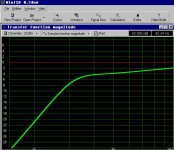Is there such a thing as too flat?
I've been playing with Martin King's Mathcad transmission line programs, and I've come up with a box for a certain (rather pricy) 5 1/4 inch mid/bass. The design shows a response curve that's razor flat down to about 40Hz and not off too much at 30Hz. I wonder if it would sound boomy in a typical small to medium size room, due to room gain.
But then again, I may be fooling myself. The amount of stuffing material called for is well over 1 lb per cubic foot in the middle part of the line. The worksheet has a comment in it suggesting the density should be in the range 0 to 1. Martin, if you are listening, do the calculations break down at relatively high stuffing densities?
I've been playing with Martin King's Mathcad transmission line programs, and I've come up with a box for a certain (rather pricy) 5 1/4 inch mid/bass. The design shows a response curve that's razor flat down to about 40Hz and not off too much at 30Hz. I wonder if it would sound boomy in a typical small to medium size room, due to room gain.
But then again, I may be fooling myself. The amount of stuffing material called for is well over 1 lb per cubic foot in the middle part of the line. The worksheet has a comment in it suggesting the density should be in the range 0 to 1. Martin, if you are listening, do the calculations break down at relatively high stuffing densities?
Martin, if you are listening, do the calculations break down at relatively high stuffing densities?
Yes! The curve fit I use for stuffing is smooth up to 1 lb/ft^3 and then oscillates all over the place. I my opinion, using stuffing densities well above 0.75 lb/ft^3 indicates that stuffing is being used to correct a bad geometry design. I believe a good TL design should use stuffing densities between 0.25 and 0.5 lb/ft^3.
You probably listen to room gain. Anechoically flat curves sound boomy inroom.
I agree fully.
An externally hosted image should be here but it was not working when we last tested it.
Brown dashed line = Combined response of room gain and baffle diffraction loss for a baffle between 25 to 30 cm
Blue dashed line = Example of an adapted 2 Pi loudspeaker frequency response
Red line = Resulting in room sound response
While this adjusts the substantial room-gain and baffle diffraction loss, the room modes and resonances have not been eliminated! Nevertheless, you will be surprised to which degree the so-far boomy bass has been eliminated too. The ear seems to be tolerant to room modes as long as the overall balance is guaranted.
http://www.arsenal.net/speakers/allison/royart.zip (look out - file size approx. 3meg)
advance
i have a jBL 2226 in 33hz 175L heres its response=
it sounds very nice!.
in my 2.2mx4m room with low ceiling,the walls vibrate noticably with 20watts.
im interested in measuring my SPLs at various positions
should i just use sinewaves,note each SPL at measured positions and then compare?
the subs in a corner position
when i get SPL meter i will do this and post results perhaps.
cheers
it sounds very nice!.
in my 2.2mx4m room with low ceiling,the walls vibrate noticably with 20watts.
im interested in measuring my SPLs at various positions
should i just use sinewaves,note each SPL at measured positions and then compare?
the subs in a corner position
when i get SPL meter i will do this and post results perhaps.
cheers
Attachments
Room Frequency Response Measurements
In my opinion, room frequency response measurements are generally speaking somewhat delicate. Pink noise and RTA measurements are often unreliable. Our ears tend to ignore late reflections in the treble region while adding some weight in the mid-range and even more weight in the bass region. So, theoretically an adaptiv room frequency response measurement should be used, which excludes most room reflections at high frequencies (except approx. the first 10 ms), includes more reflections in the midrange and includes nearly all room reflections in the bass region (up to approx. 200 ms at a frequency resolution of 1/3 octave).
So, your proposed measurement setup may be all right as long as it is limited to the bass region (up to approx. 150Hz) and you smooth out room modes manually.
advance
should i just use sinewaves,note each SPL at measured positions...
In my opinion, room frequency response measurements are generally speaking somewhat delicate. Pink noise and RTA measurements are often unreliable. Our ears tend to ignore late reflections in the treble region while adding some weight in the mid-range and even more weight in the bass region. So, theoretically an adaptiv room frequency response measurement should be used, which excludes most room reflections at high frequencies (except approx. the first 10 ms), includes more reflections in the midrange and includes nearly all room reflections in the bass region (up to approx. 200 ms at a frequency resolution of 1/3 octave).
So, your proposed measurement setup may be all right as long as it is limited to the bass region (up to approx. 150Hz) and you smooth out room modes manually.
advance
- Status
- This old topic is closed. If you want to reopen this topic, contact a moderator using the "Report Post" button.
